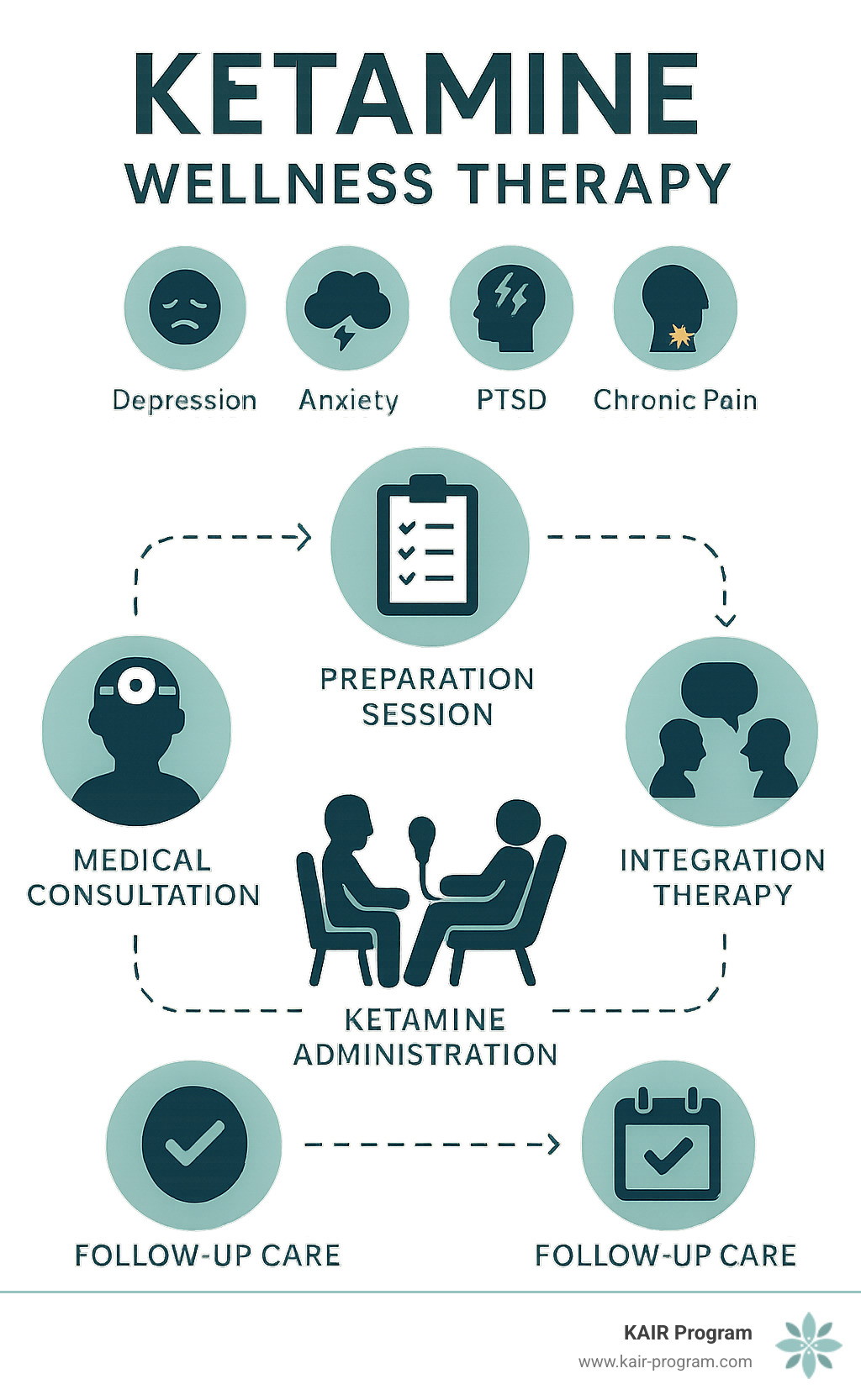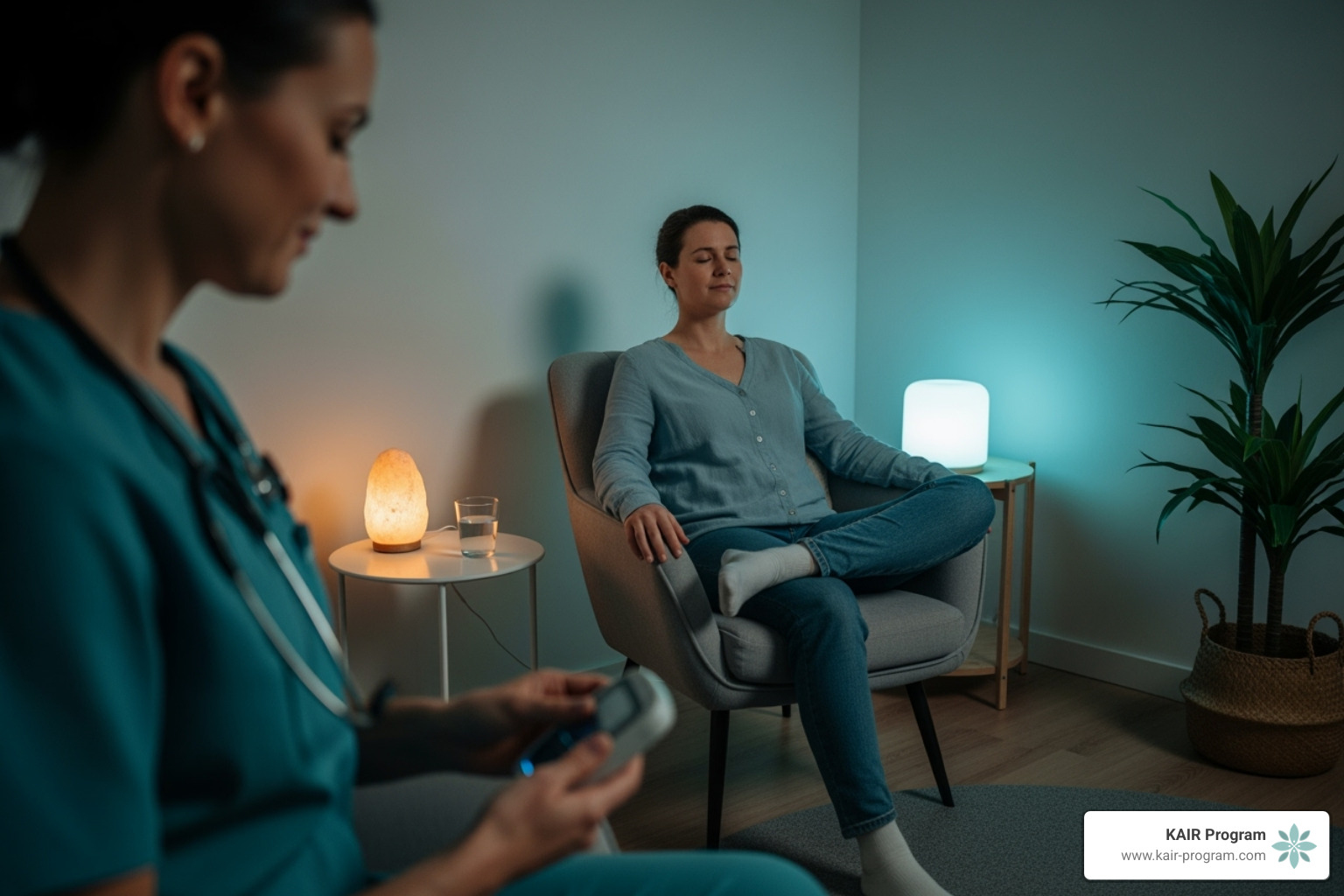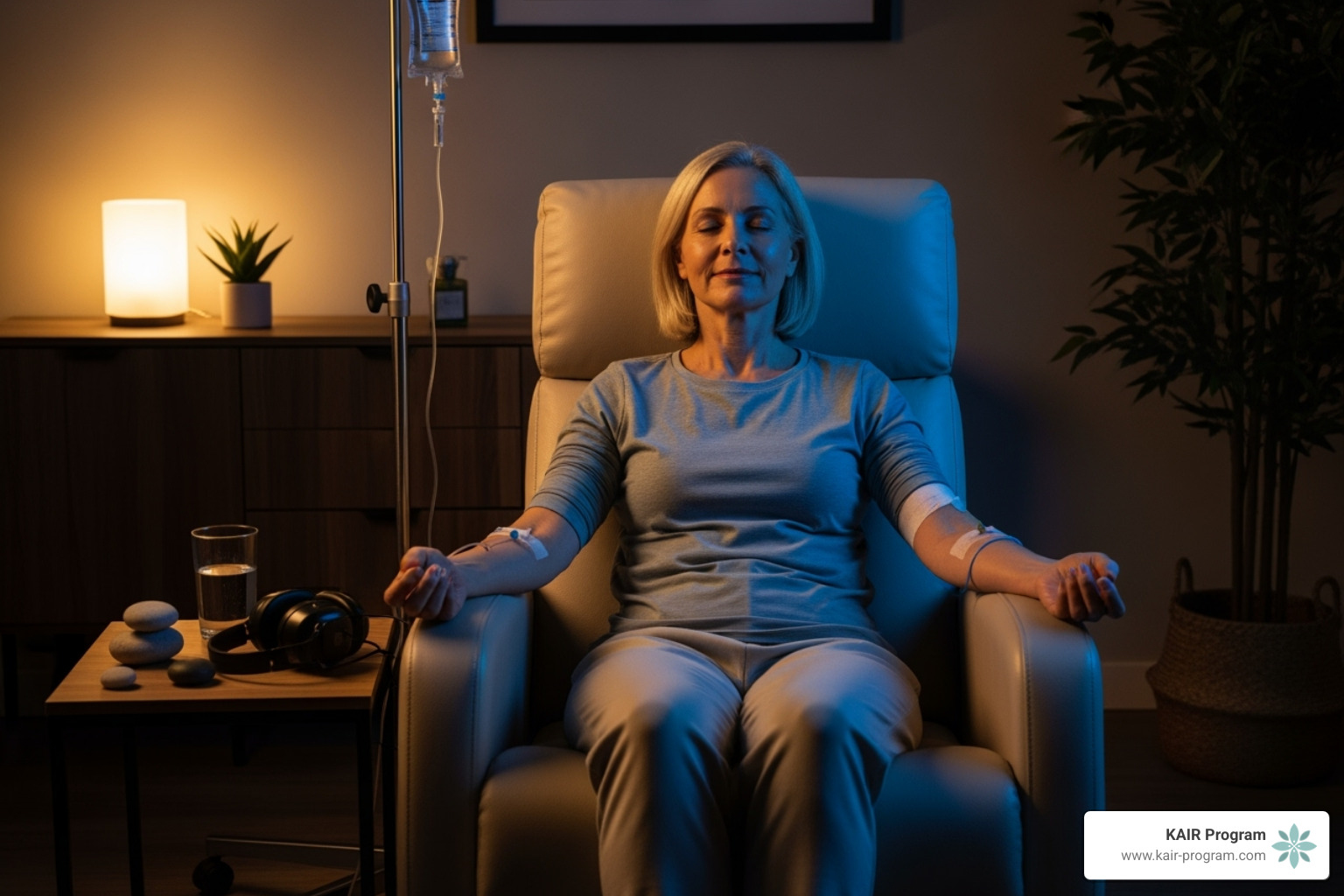Ketamine Wellness Therapy: A Dose of Hope for Depression and Anxiety
A Revolutionary Approach to Mental Health Treatment

Ketamine wellness therapy is a breakthrough treatment combining low-dose ketamine with psychotherapy to rapidly treat depression, anxiety, PTSD, and chronic pain. Unlike traditional antidepressants that take weeks to work, ketamine can provide relief within hours by promoting neuroplasticity—the brain's ability to form new neural pathways.
What is Ketamine Wellness Therapy?
- A medical treatment using sub-anesthetic doses of ketamine.
- Combined with psychotherapy for improved, lasting healing.
- Treats conditions like treatment-resistant depression, anxiety, and PTSD.
- Works by promoting brain neuroplasticity for rapid relief.
Who Can Benefit?
- Individuals with treatment-resistant mental health conditions.
- Those who haven't responded to traditional therapy or medications.
- People seeking rapid, lasting relief from debilitating symptoms.
For many, traditional treatments provide limited relief, leaving them searching for alternatives. This is where ketamine wellness therapy offers hope. For Sarah Gutilla, whose treatment-resistant depression had become life-threatening, the change was immediate. "The amount of relief I felt after the first treatment was what I think 'normal' is supposed to feel like," she says. "I've never felt so OK and so at peace."
Over 80% of patients report significant improvement after their first few infusions. The treatment creates a "neuroplastic window," a temporary state where the brain is more adaptable to positive change. As Dr. Bambi Rattner, PsyD, I've seen how ketamine wellness therapy, when integrated with intensive trauma-focused therapy, creates lasting healing for even the most treatment-resistant conditions.

What is Ketamine and Who Can It Help?
Originally developed in 1962 as a safer anesthetic, ketamine saved countless lives on Vietnam War battlefields and in operating rooms. The World Health Organization even added it to their List of Essential Medicines for its safety. Soon, doctors noticed an unexpected benefit: patients felt better emotionally after procedures. This observation sparked decades of research into what is now ketamine wellness therapy.
Today, we use much lower, sub-anesthetic doses to address conditions that have left millions searching for answers. With depression as the leading cause of disability in the U.S. for ages 15-44, exploring every safe, effective option is critical.
Mental Health Conditions Treated
While conventional antidepressants can take weeks to show effects, ketamine often provides relief within hours or days, a life-saving difference for many.
- Treatment-Resistant Depression (TRD): This is ketamine's most well-known application. Research shows repeated infusions can produce a 47.2% reduction in depression symptoms for people with TRD.
- Major Depressive Disorder (MDD): Patients can experience rapid relief from severe symptoms, often surprising themselves and their families.
- Post-Traumatic Stress Disorder (PTSD): One study showed 67% of patients with chronic PTSD responded positively to ketamine. It helps people process trauma and find new perspectives. Learn more on our page about Ketamine for PTSD Treatment.
- Anxiety Disorders: Ketamine can significantly lessen the persistent worry and fear that dominate daily life, allowing people to re-engage with their world.
- Suicidal Ideation: Ketamine often reduces suicidal thoughts within hours, making it a crucial intervention in emergencies.
- Other Conditions: Research is exploring ketamine's potential for OCD, the depressive phases of Bipolar Disorder, Substance Use Disorders, and End-of-Life Distress. For more, visit our resource on Ketamine for Mood Disorders.
Chronic Pain Conditions Treated
Beyond mental health, ketamine's unique ability to modulate pain signals makes it effective for chronic pain that doesn't respond to conventional treatments.

- Neuropathic Pain: Caused by nerve damage, this condition responds particularly well. A review of 14 studies found significant improvements in 13 of them.
- Complex Regional Pain Syndrome (CRPS): Ketamine offers hope for this debilitating condition, which causes severe, prolonged pain and inflammation.
- Fibromyalgia: This therapy can address the widespread pain, fatigue, and sleep problems associated with fibromyalgia.
- Chronic Migraines: For those whose lives are disrupted by severe, frequent migraines, ketamine can be transformative.
A study in the Journal of Pain Research found ketamine led to a 28% to 46% reduction in pain intensity up to 30 days after treatment, demonstrating its potential for sustained improvement. Explore more research on ketamine for chronic pain.
The Science Behind the Healing: How Ketamine Rewires the Brain
The healing power of ketamine wellness therapy lies in what happens at a cellular level. For conditions like depression or trauma, think of your brain's neural pathways as damaged highways. Ketamine helps build new routes and repair old ones through a process called neuroplasticity—your brain's ability to reorganize and form new connections.
Unlike traditional SSRIs that adjust serotonin levels over weeks, ketamine creates rapid changes in brain structure. It promotes synaptogenesis (the formation of new connections between brain cells) and boosts Brain-Derived Neurotrophic Factor (BDNF), which acts like fertilizer for your neurons, helping them grow stronger.
This creates a temporary but powerful neuroplastic window, where the brain is more adaptable to positive change. This makes it the perfect time to integrate new insights through therapy. For a deeper dive, visit our page on How Does Ketamine Therapy Work.
The Role of Glutamate and NMDA Receptors

To understand how ketamine works, we need to look at glutamate, the brain's primary communication chemical. Ketamine is an NMDA receptor antagonist. It temporarily blocks specific doorways on brain cells, causing a controlled glutamate surge.
This surge activates other receptors (AMPA receptors), triggering a cascade of healing processes that promote the growth of new neural connections. The result is improved brain communication and the formation of healthier neural pathways. Your brain literally begins to rewire itself in more positive ways.
Research published in Nature confirms this glutamate-mediated process is crucial for restoring neural pathways damaged by chronic stress or depression. The scientific research on glutamate's role shows how ketamine's unique mechanism creates rapid, lasting changes in brain function, representing a new approach to mental health treatment.
The Treatment Journey: Administration, Experience, and Integration
Starting ketamine wellness therapy is a carefully guided journey. At KAIR Program, every step happens in a supervised clinical setting where your safety and comfort are our top priorities. Our team is here to walk alongside you through every phase. For a comprehensive overview, visit our page on What to Expect.
Comparing Ketamine Administration Methods
There isn't a one-size-fits-all approach to ketamine administration. The method depends on your specific needs and treatment goals, as each has a different bioavailability (how much medication reaches the bloodstream), onset, and duration.
| Method | Bioavailability | Onset of Effects | Duration of Effects | Level of Control | Typical Use Case |
|---|---|---|---|---|---|
| Intravenous (IV) Infusion | Nearly 100% | Immediate (within minutes) | 40-60 minutes | Highly precise | Rapid and potent effects, dose titration, initial treatments |
| Intramuscular (IM) Injection | Approx. 90% | 5-15 minutes | Approx. 60 minutes | Moderate | Rapid onset for convenience, less precise than IV |
| Oral (Lozenges/Troches) | 24-32.2% | 15-20 minutes | 1-2 hours | Lower | Maintenance therapy, at-home use, less intense experience |
IV infusion offers the most precise dosage control. IM injection is valued for its simplicity and rapid onset. Oral lozenges are often used for maintenance therapy. Our team evaluates which method will serve you best, prioritizing safety and effectiveness. Find more information on ketamine administration from KAIR Program.
The Patient Experience in Ketamine Wellness Therapy
Every ketamine experience is unique. Preparation begins with medical and psychological screening and setting clear intentions for your session. The concept of "set and setting"—your mindset and the environment—is fundamental. Our therapeutic spaces are designed to be calm and supportive, creating a "safe container" for your experience.
During the session, a licensed provider monitors you continuously. The effects typically begin within minutes, leading to a dissociative experience—a gentle disconnection from your body or ordinary reality. This can be a deeply spiritual or introspective experience. We encourage patients to surrender to the journey as it unfolds.
Post-treatment, you may feel drowsy or light-headed, which is normal. We require you to have a designated driver and encourage rest and reflection. These experiences can be transformative, especially within our intensive retreat setting. Learn more about our Ketamine Assisted Intensive Retreats.
The Crucial Role of Psychotherapy and Integration
While ketamine opens new neural pathways, lasting change comes from psychotherapy and integration. The medicine creates a neuroplastic window, typically lasting for about two days, which is a golden opportunity for therapeutic work.

At KAIR Program, we maximize this window by combining ketamine with intensive, trauma-focused therapy. Integration sessions help you make meaning of your experience, cultivate new perspectives, and develop coping strategies. For those with trauma, pairing ketamine with modalities like EMDR or IFS can be incredibly powerful for reprocessing difficult memories.
This integration of the psychedelic experience with structured therapy is what leads to sustained benefits and profound, lasting healing. For more on this combined approach, explore our resources on Ketamine Assisted Psychotherapy.
Understanding Ketamine Wellness Therapy: Efficacy, Safety, and Cost
Making an informed decision about your health is crucial. Our process includes thorough patient screening to ensure ketamine wellness therapy is the right path for you. For more on its effectiveness, visit our page on Ketamine Therapy Effectiveness.
Efficacy and Success Rates
The evidence supporting ketamine's effectiveness is compelling, especially for treatment-resistant conditions.
- Over 80% of patients report significant improvement in anxiety and depression after the first few infusions, with some feeling better in as little as four hours.
- For depression, one trial found 55% of patients receiving ketamine had at least a 50% symptom improvement, compared to 41% receiving ECT. Another review found a 47.2% reduction in symptoms for those with treatment-resistant depression.
- For PTSD, a trial showed 67% of patients responded positively to ketamine, compared to 30% in the placebo group.
- For chronic pain, studies show significant pain reduction. One reported a 28% to 46% drop in pain intensity that lasted up to 30 days post-treatment.
These statistics highlight ketamine as a rapid, effective alternative. A Harvard study on ketamine for depression provides more insights, and you can read our patients' journeys on our Ketamine Therapy Success Stories page.
Safety, Risks, and Side Effects
When administered in a controlled medical setting, ketamine has an outstanding safety record. We monitor your vital signs throughout the session.
Most side effects are short-term and resolve quickly, including mild nausea, dizziness, or temporary disorientation. The dissociative experience can be intense but is often therapeutic; our team provides support throughout.
Long-term risks are extremely low with infrequent, controlled therapeutic doses. Concerns about bladder issues or dependence are typically associated with chronic, high-dose recreational abuse, not therapeutic use.
Contraindications are important. We carefully screen for conditions like uncontrolled hypertension, certain heart diseases, or active psychosis, as ketamine is not suitable for everyone.
Regulations, Cost, and Insurance Coverage
Ketamine's use for mental health is considered "off-label," which is legal but often creates challenges for insurance coverage. The industry has grown rapidly, reflecting the high demand for innovative mental health solutions.
Cost is a significant consideration, with sessions typically ranging from $400 to $1,000. This cost reflects the medical supervision, facility, and essential therapeutic support provided.
Insurance coverage remains a challenge, and most plans do not cover ketamine for mental health. We believe in complete transparency and will discuss all financial aspects with you during your consultation. For more details, please refer to our page on Ketamine Therapy Cost.
Frequently Asked Questions about Ketamine Therapy
It's natural to have questions when considering ketamine wellness therapy. Here are answers to some of the most common concerns.
Who is an ideal candidate for ketamine therapy?
Ideal candidates are often those who have struggled with treatment-resistant conditions despite trying multiple traditional therapies and medications. They are medically cleared, psychologically prepared for the unique experience, and, most importantly, motivated for change. They understand that ketamine is a powerful tool that works best when combined with therapeutic work. The therapy is generally not suitable for individuals with active psychosis or uncontrolled cardiovascular disease.
Is ketamine therapy addictive?
When used in a medical setting with proper supervision, the risk of addiction is very low. We use infrequent, controlled doses, which is vastly different from high-frequency recreational use. Unlike opioids, ketamine does not create physical dependence. While high-dose recreational use carries risks of psychological dependence and health problems, this is minimal with carefully managed therapeutic use. Our integration of psychotherapy further reduces any potential for misuse. You can explore research on recreational use risks to understand the difference.
How long do the antidepressant effects of ketamine last?
Ketamine is known for its rapid onset, with many people feeling better within hours to days. The duration of these effects varies by individual. To achieve sustained improvement, we typically recommend an initial series of treatments (e.g., six sessions over two to three weeks). After this, some people benefit from periodic booster or maintenance sessions.
The importance of integration therapy is key to lasting results. Working with a therapist during the post-treatment neuroplastic window helps translate the insights from your session into real-world changes, extending the benefits far beyond what the medicine alone provides.
Conclusion: A New Paradigm for Mental Health
For too long, recovery from depression, anxiety, and PTSD has been viewed as a slow, uncertain process. Ketamine wellness therapy represents a fundamental shift in how we approach healing. When a patient told us, "I remembered what hope feels like" after her first session, it captured the power of this treatment.
The science is clear: ketamine works differently. It actively promotes neuroplasticity, giving your brain a chance to form new, healthier neural pathways and break free from harmful patterns.
At KAIR Program, we believe the medicine is a catalyst, not a cure-all. Our unique approach combines ketamine's neuroplastic effects with intensive, trauma-focused therapy. Lasting change happens when skilled therapists help you process insights and integrate them into your life. This method addresses root causes, not just symptoms, creating a powerful pathway to lasting healing.
Your journey doesn't have to be one of endless suffering. If traditional treatments haven't worked and you're ready to explore what real healing looks like, we're here for you.
Take a brave step toward reclaiming your life. When you're ready to explore this innovative path to wellness, we invite you to begin your journey to healing with PTSD treatment.
The future of mental health treatment is here. And it's full of hope.
